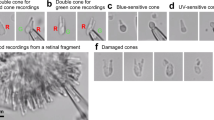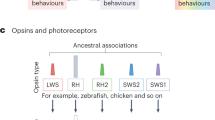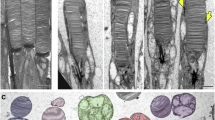Abstract
SINCE Baylor, Fuortes and O'Bryan1 first demonstrated interactions between vertebrate photoreceptor cells, many types of inter-receptor influences have been described2–10. While some of these interactions are mediated by horizontal cells1,2,6, others apparently result from direct contact between the photorecep-tors themselves1,3,4,7–10. Fain et al.10 reported that the red rods of the toad Bufo marinus were coupled by gap (electronic) junctions, and that single rods received detectable signals from other receptors over a retinal area of about 0.5 mm2. This receptive field area is 4–100 times larger than those measured for photoreceptors of a variety of species1,4,7,9,11,12,15. Fain et al. found this extensive spread of rod signals to be inconsistent with network models containing only passive elements and this raised the possibility that some active process, perhaps in the rod membrane, contributed to the spread of rod signals. We report here results which indicate that single rods sum signals over only 1/16th the area previously estimated; this smaller receptive field area implies more intrinsic noise, a larger response to single photon absorptions, and a larger signal-to-noise ratio than predicted by the previously reported results10. Furthermore we find that, as in other species (ref. 13, and Copenhagen and Owen, personal communication),the spread of low-amplitude, light-evoked responses between photoreceptors can be accounted for by purely passive electrical properties.
This is a preview of subscription content, access via your institution
Access options
Subscribe to this journal
Receive 51 print issues and online access
$199.00 per year
only $3.90 per issue
Buy this article
- Purchase on SpringerLink
- Instant access to full article PDF
Prices may be subject to local taxes which are calculated during checkout
Similar content being viewed by others
References
Baylor, D. A., Fuortes, M. G. F. & O'Bryan, P. M. J. Physiol., Lond. 214, 265–294 (1971).
Fuortes, M. G. F. & Simon, E. J. J.Physiol., Lond. 240, 177–198 (1974).
Fain, G. L. Science 187, 838–841 (1975).
Schwartz, E. A. J. Physiol., Lond. 232, 503–514 (1973).
Schwartz, E. A. J. Physiol., Lond. 246, 639–651 (1975).
Stell, W. K., Lightfoot, D. O., Wheeler, T. G. & Leeper, H. F. Science 190, 989–990 (1975).
Copenhagen, D. R. & Owen, W. G. J. Physiol., Lond. 259, 251–282 (1976).
Copenhagen, D. R. & Owen, W. G. Nature 260, 57–59 (1976).
Nelson, R. J. comp. Neural. 172, 109–136 (1977).
Fain, G. L., Gold, G. H. & Dowling, J. E. Cold Spring Harb. Symp. quant. Biol. 40, 547–561 (1976).
Werblin, F. S. J. Neurophysiol. 33, 342–350 (1970).
Lasansky, A. & Marchiafava, P. L. J. Physiol., Lond. 236, 171–191 (1974).
Lamb, T. D. & Simon, E. J. J. Physiol., Lond. 263, 257–286 (1976).
Brown, J. E. & Pinto, L. H. J. Physiol., Lond. 236, 575–591 (1974).
Normann, R. A. & Pochobradský, J. J. Physiol., Lond. 261, 15–29 (1976).
Liebman, P. A. & Entine, G. Vision Res. 8, 761–775 (1968).
Hárosi, F. I. J. gen. Physiol. 66, 357–382 (1975).
Lamb, T. D. J. Physiol., Lond. 263, 239–255 (1976).
Jack, J. J. B., Noble, D. & Tsien, R. W. Electrical Current Flow in Excitable Cells (Clarendon, Oxford, 1975).
Fain, G. L. J Physiol., Lond. 261, 71–101 (1976).
Griff, E. R. & Pinto, L. H. Soc. Neurosci. Abstr. 3, 561 (1977).
Detwiler, P. B., Hodgkin, A. L. & McNaughton, P. A. Nature 274, 562–565 (1978).
Author information
Authors and Affiliations
Rights and permissions
About this article
Cite this article
LEEPER, H., NORMANN, R. & COPENHAGEN, D. Evidence for passive electrotonic interactions in red rods of toad retina. Nature 275, 234–236 (1978). https://doi.org/10.1038/275234b0
Received:
Accepted:
Issue date:
DOI: https://doi.org/10.1038/275234b0



